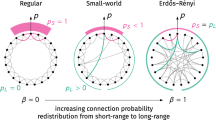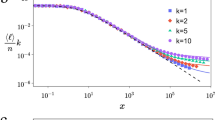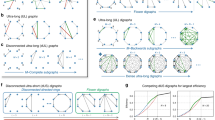It is easier to find short chains between points in some networks than others.
Abstract
The small-world phenomenon — the principle that most of us are linked by short chains of acquaintances — was first investigated as a question in sociology1,2 and is a feature of a range of networks arising in nature and technology3,4,5. Experimental study of the phenomenon1 revealed that it has two fundamental components: first, such short chains are ubiquitous, and second, individuals operating with purely local information are very adept at finding these chains. The first issue has been analysed2,3,4, and here I investigate the second by modelling how individuals can find short chains in a large social network.
Similar content being viewed by others
Main
I have found that the cues needed for discovering short chains emerge in a very simple network model. This model is based on early experiments1, in which source individuals in Nebraska attempted to transmit a letter to a target in Massachusetts, with the letter being forwarded at each step to someone the holder knew on a first-name basis. The networks underlying the model follow the ‘small-world’ paradigm3: they are rich in structured short-range connections and have a few random long-range connections.
Long-range connections are added to a two-dimensional lattice controlled by a clustering exponent, α, that determines the probability of a connection between two nodes as a function of their lattice distance ( Fig. 1a). Decentralized algorithms are studied for transmitting a message: at each step, the holder of the message must pass it across one of its short- or long-range connections; crucially, this current holder does not know the long-range connections of nodes that have not touched the message. The primary figure of merit for such an algorithm is its expected delivery time T, which represents the expected number of steps needed to forward a message between a random source and target in a network generated according to the model. It is crucial to constrain the algorithm to use only local information — with global knowledge of all connections in the network, the shortest chain can be found very simply6.
a, The network model is derived from an n × n lattice. Each node, u, has a short-range connection to its nearest neighbours (a, b, c and d) and a long-range connection to a randomly chosen node, where node v is selected with probability proportional to r −α, where r is the lattice (‘Manhattan’) distance between u and v, and α≥0 is a fixed clustering exponent. More generally, for p ,q≥1, each node u has a short-range connection to all nodes within p lattice steps, and q long-range connections generated independently from a distribution with clustering exponent α. b, Lower bound from my characterization theorem: when α ≠ 2, the expected delivery time T of any decentralized algorithm satisfies T ≥ cn β, where β =(2 − α)/3 for 0 ≤α< 2 and β=(α−2)/(α−1) for α>2, and where c depends on α, p and q, but not n. c, Simulation of the greedy algorithm on a 20,000 × 20,000 toroidal lattice, with random long-range connections as in a. Each data point is the average of 1,000 runs.
A characteristic feature of small-world networks is that their diameter is exponentially smaller than their size, being bounded by a polynomial in logN, where N is the number of nodes. In other words, there is always a very short path between any two nodes. This does not imply, however, that a decentralized algorithm will be able to discover such short paths. My central finding is that there is in fact a unique value of the exponent α at which this is possible.
When α = 2, so that long-range connections follow an inverse-square distribution, there is a decentralized algorithm that achieves a very rapid delivery time; T is bounded by a function proportional to (logN )2. The algorithm achieving this bound is a ‘greedy’ heuristic: each message holder forwards the message across a connection that brings it as close as possible to the target in lattice distance. Moreover, α = 2 is the only exponent at which any decentralized algorithm can achieve a delivery time bounded by any polynomial in logN: for every other exponent, an asymptotically much larger delivery time is required, regardless of the algorithm employed (Fig. 1b).
These results indicate that efficient navigability is a fundamental property of only some small-world structures. The results also generalize to d-dimensional lattices for any value of d≥1, with the critical value of the clustering exponent becoming α = d. Simulations of the greedy algorithm yield results that are qualitatively consistent with the asymptotic analytical bounds (Fig. 1c).
In the areas of communication networks7 and neuroanatomy8, the issue of routing without a global network organization has been considered; also in social psychology and information foraging some of the cues that individuals use to construct paths through a social network or hyperlinked environment have been discovered9,10. Although I have focused on a very clean model, I believe that a more general conclusion can be drawn for small-world networks — namely that the correlation between local structure and long-range connections provides critical cues for finding paths through the network.
When this correlation is near a critical threshold, the structure of the long-range connections forms a type of gradient that allows individuals to guide a message efficiently towards a target. As the correlation drops below this critical value and the social network becomes more homogeneous, these cues begin to disappear; in the limit, when long-range connections are generated uniformly at random, the result is a world in which short chains exist but individuals, faced with a disorienting array of social contacts, are unable to find them.
References
Milgram, S. Psychol. Today 1, 61–67 (1967).
Kochen, M. (ed.) The Small World (Ablex, Norwood, NJ, 1989).
Watts, D. & Strogatz, S. Nature 393, 440–442 (1998).
Albert, R. et al. Nature 401, 130–131 (1999).
Adamic, L. in Proc. 3rd European Conference on Digital Libraries (eds Abiteboul, S. & Vercoustre, A.-M) 443–452 (Springer Lecture Notes in Computer Science, Vol. 1696, Berlin, 1999).
Cormen, T., Leiserson, C. & Rivest, R. Introduction to Algorithms (McGraw-Hill, Boston, 1990).
Peleg, D. & Upfal, E. J. Assoc. Comput. Machinery 36, 510–530 (1989).
Braitenberg, V. & Schüz, A. Anatomy of the Cortex (Springer, Berlin, 1991).
Killworth, P. & Bernard, H. Social Networks 1, 159–192 (1978).
Pirolli, P. & Card, S. Psychol. Rev. 106, 643–675 (1999).
Author information
Authors and Affiliations
Rights and permissions
About this article
Cite this article
Kleinberg, J. Navigation in a small world. Nature 406, 845 (2000). https://doi.org/10.1038/35022643
Issue Date:
DOI: https://doi.org/10.1038/35022643
This article is cited by
-
Diversity of information pathways drives sparsity in real-world networks
Nature Physics (2024)
-
Hyper-distance oracles in hypergraphs
The VLDB Journal (2024)
-
On quantification and maximization of information transfer in network dynamical systems
Scientific Reports (2023)
-
Greedy routing optimisation in hyperbolic networks
Scientific Reports (2023)
-
Brain network communication: concepts, models and applications
Nature Reviews Neuroscience (2023)
Comments
By submitting a comment you agree to abide by our Terms and Community Guidelines. If you find something abusive or that does not comply with our terms or guidelines please flag it as inappropriate.




